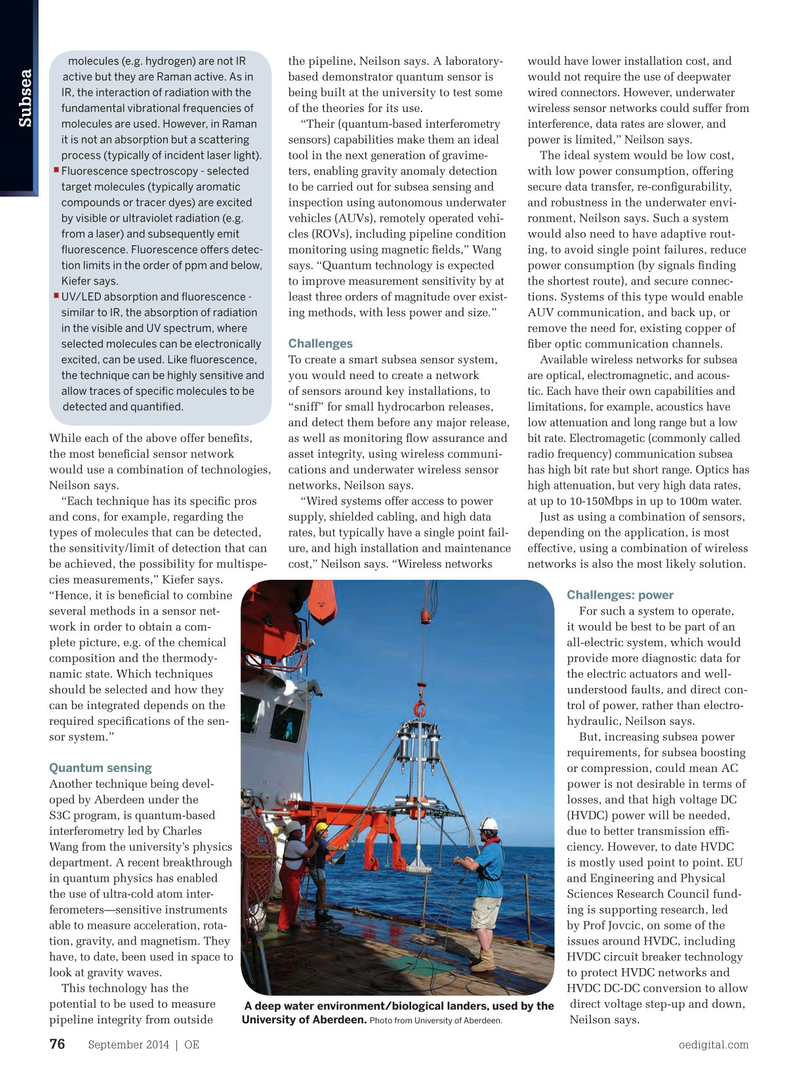
Page 74: of Offshore Engineer Magazine (Sep/Oct 2014)
Read this page in Pdf, Flash or Html5 edition of Sep/Oct 2014 Offshore Engineer Magazine
molecules (e.g. hydrogen) are not IR would have lower installation cost, and the pipeline, Neilson says. A laboratory- active but they are Raman active. As in would not require the use of deepwater based demonstrator quantum sensor is
IR, the interaction of radiation with the wired connectors. However, underwater being built at the university to test some fundamental vibrational frequencies of wireless sensor networks could suffer from of the theories for its use.
Subsea molecules are used. However, in Raman interference, data rates are slower, and “Their (quantum-based interferometry it is not an absorption but a scattering power is limited,” Neilson says. sensors) capabilities make them an ideal process (typically of incident laser light). tool in the next generation of gravime- The ideal system would be low cost, • Fluorescence spectroscopy - selected ters, enabling gravity anomaly detection with low power consumption, offering target molecules (typically aromatic to be carried out for subsea sensing and secure data transfer, re-confgurability, compounds or tracer dyes) are excited inspection using autonomous underwater and robustness in the underwater envi- by visible or ultraviolet radiation (e.g. vehicles (AUVs), remotely operated vehi- ronment, Neilson says. Such a system from a laser) and subsequently emit cles (ROVs), including pipeline condition would also need to have adaptive rout- fuorescence. Fluorescence ofers detec- monitoring using magnetic felds,” Wang ing, to avoid single point failures, reduce tion limits in the order of ppm and below, says. “Quantum technology is expected power consumption (by signals fnding
Kiefer says.
to improve measurement sensitivity by at the shortest route), and secure connec- • UV/LED absorption and fuorescence - least three orders of magnitude over exist- tions. Systems of this type would enable similar to IR, the absorption of radiation ing methods, with less power and size.” AUV communication, and back up, or in the visible and UV spectrum, where remove the need for, existing copper of selected molecules can be electronically
Challenges fber optic communication channels.
excited, can be used. Like fuorescence,
To create a smart subsea sensor system,
Available wireless networks for subsea the technique can be highly sensitive and are optical, electromagnetic, and acous-you would need to create a network allow traces of specifc molecules to be tic. Each have their own capabilities and of sensors around key installations, to detected and quantifed.
limitations, for example, acoustics have “sniff” for small hydrocarbon releases, low attenuation and long range but a low and detect them before any major release,
While each of the above offer benefts, as well as monitoring fow assurance and bit rate. Electromagetic (commonly called the most benefcial sensor network asset integrity, using wireless communi- radio frequency) communication subsea would use a combination of technologies, cations and underwater wireless sensor has high bit rate but short range. Optics has
Neilson says. networks, Neilson says. high attenuation, but very high data rates, “Wired systems offer access to power “Each technique has its specifc pros at up to 10-150Mbps in up to 100m water. supply, shielded cabling, and high data and cons, for example, regarding the Just as using a combination of sensors, rates, but typically have a single point fail- types of molecules that can be detected, depending on the application, is most ure, and high installation and maintenance the sensitivity/limit of detection that can effective, using a combination of wireless cost,” Neilson says. “Wireless networks be achieved, the possibility for multispe- networks is also the most likely solution. cies measurements,” Kiefer says.
Challenges: power “Hence, it is benefcial to combine several methods in a sensor net- For such a system to operate, work in order to obtain a com- it would be best to be part of an plete picture, e.g. of the chemical all-electric system, which would composition and the thermody- provide more diagnostic data for namic state. Which techniques the electric actuators and well- should be selected and how they understood faults, and direct con- can be integrated depends on the trol of power, rather than electro- required specifcations of the sen- hydraulic, Neilson says. sor system.” But, increasing subsea power
Providing subsea power requirements, for subsea boosting
Quantum sensing or compression, could mean AC
Another technique being devel- power is not desirable in terms of and control to global oped by Aberdeen under the losses, and that high voltage DC
S3C program, is quantum-based (HVDC) power will be needed, offshore energy interferometry led by Charles due to better transmission eff-
Wang from the university’s physics ciency. However, to date HVDC department. A recent breakthrough is mostly used point to point. EU systems.
in quantum physics has enabled and Engineering and Physical the use of ultra-cold atom inter- Sciences Research Council fund- ferometers—sensitive instruments ing is supporting research, led able to measure acceleration, rota- by Prof Jovcic, on some of the tion, gravity, and magnetism. They issues around HVDC, including
Visit us at stand O40-B at Rio Oil & Gas have, to date, been used in space to HVDC circuit breaker technology look at gravity waves. to protect HVDC networks and
This technology has the HVDC DC-DC conversion to allow UNITED KINGDOM • UNITED STATES • THAILAND • SINGAPORE • MALAYSIA • GERMANY • BRASIL
WWW.JDRGLOBAL.COM potential to be used to measure direct voltage step-up and down, A deep water environment/biological landers, used by the
University of Aberdeen. Photo from University of Aberdeen. pipeline integrity from outside Neilson says.
September 2014 | OE oedigital.com 76 074_0914_subsea1.indd 76 8/21/14 5:28 PM

 73
73

 75
75